The Incidence of Gastrointestinal Disease Increases with Heat and Cold
In Spain, hospital admissions related to these infections increase by 21% at high temperatures and 7% at cold temperatures
25.10.2018
Heat increases the number of gastroenteritis-related hospital admissions by 21%, while cold increases them by 7%. A new study performed by the Barcelona Institute for Global Health (ISGlobal), an institution supported by ”la Caixa” Foundation, analysed for the first time the association between climate and hospitalisations due to the infection over a 17 year-period in Spain.
Diarrheal diseases, although preventable and treatable, are the second leading global cause of death among children under five years of age. In 2015, 1,31 million people worldwide died from gastroenteritis.
To date, few studies have addressed the association between climate factors- temperature and rain- and gastrointestinal disease incidence in high-income countries. In most cases, heat and heavy rainfall were associated with an increase in infections.
The aim of this study, published in Environment International, was to evaluate the association between meteorological variables and gastroenteritis hospitalisations in Spain - between 1997 and 2013, 275,182 cases were registered, with an average of 44 cases per day.
Hospitalisation data were obtained from administrative records, and cases where gastroenteritis was the primary diagnosis were selected. Meteorological data were obtained from the European Climate Assessment & Dataset. The study correlated daily hospital admissions with the corresponding meteorological variables.
The results indicate that “temperature plays an important role in the increase of hospital admissions due to gastroenteritis,” explains Clara Morral Puigmal, first author of the study. In particular, the number of hospital admissions were lowest on days where the temperature was of 12°C. In contrast, hospital admissions increased by 7% on cold days (where the average temperature was of 6ºC) and by 21% on hot days with an average temperature of 26ºC.
Hot temperatures mostly increased hospitalisations due to foodborne gastroenteritis. “This is probably due to the fact that heat promotes the growth of bacteria in food,” explains ISGlobal researcher Xavier Basagaña and coordinator of the study. Rotaviral infections, in contrast, were associated with cold temperatures. In this case, “it is probably due to the fact that in cold weather we spend more time indoors, with less ventilation, which increases transmission between people,” he adds.
The study also found that rainfall decreases the risk of gastroenteritis by 26%. “This effect was unexpected,” says Basagaña, “and could be due to a lower exposure to recreational waters during rainy periods.”
The results were similar for both sexes, although women had an increased risk under extreme heat. Infants under one year of age were most susceptible to cold.
Xavier Basagaña concludes that these results are relevant in view of the climate changes we are experiencing, whereby extreme temperatures and climate events are becoming increasingly frequent.
Reference
Clara Morral-Puigmal, Èrica Martínez-Solanas, Cristina M. Villanueva, Xavier Basagaña. Weather and gastrointestinal disease in Spain: A retrospective time series regression study. Environment International. Octubre 2018. doi: 10.1016/j.envint.2018.10.003



